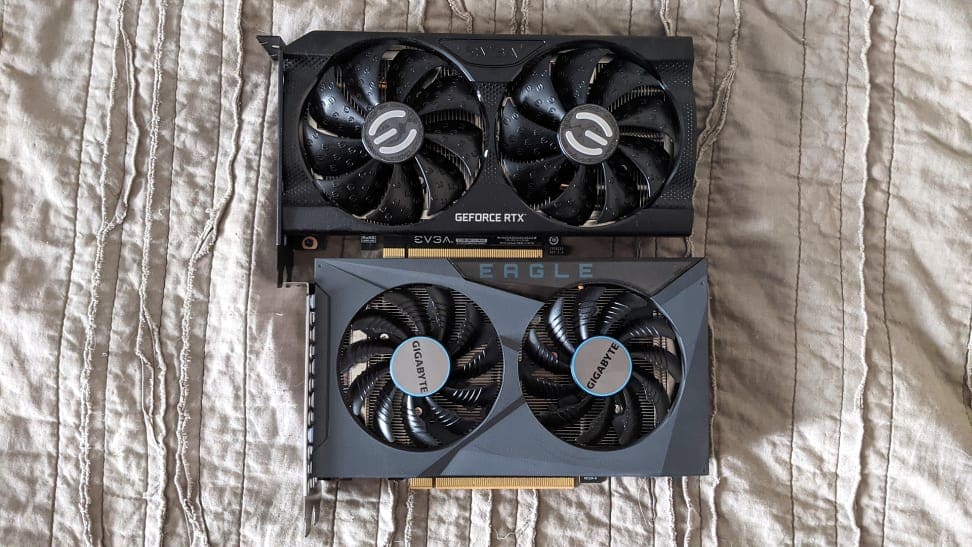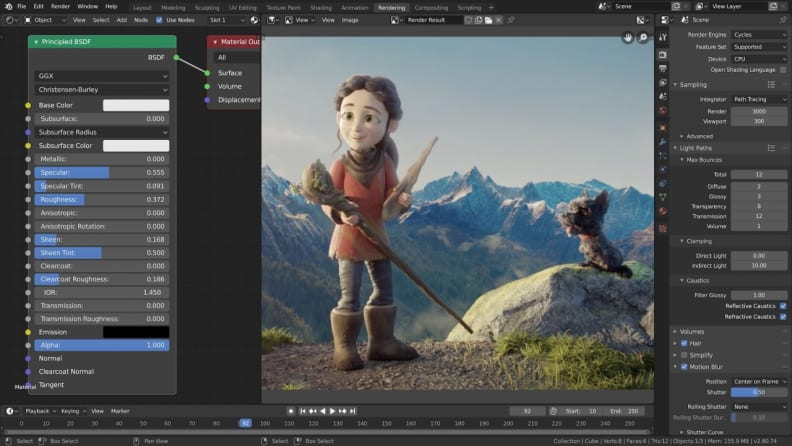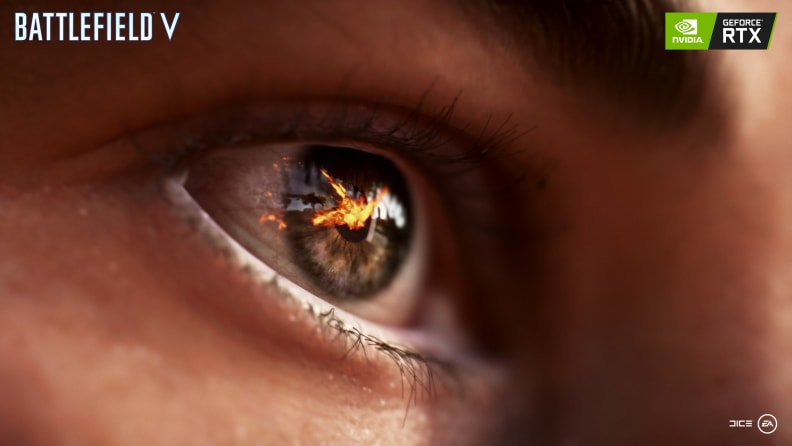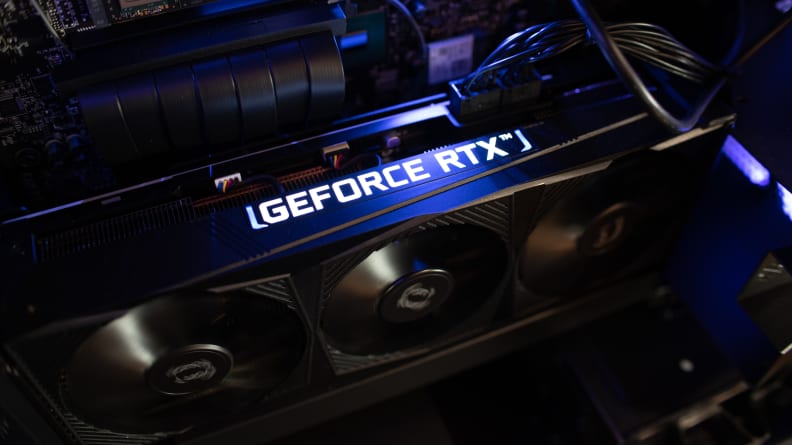AMD vs Nvidia: Which graphics card should you get?
It all depends on your personal use cases.
 Credit:
Reviewed / Joanna Nelius
Credit:
Reviewed / Joanna Nelius
Products are chosen independently by our editors. Purchases made through our links may earn us a commission.
Nvidia’s graphics cards had a comfortable lead on AMD’s cards for years, but AMD’s Radeon RX 7000-series lineup put the two brands in a competition like never before. Both manufacturers constantly add new features and update the graphics architecture in their cards to keep the competition hot, but Nvidia’s key features like ray tracing, DLSS, and frame generation have been around for longer, whereas AMD leads on price.
Ultimately, you’ll have to decide if you prefer the best frame rates or to save money you could put towards other parts of your PC.
Performance

Nvidia and AMD cards are typically at parity these days, but Nvidia offers more features for rendering and creating content.
When it comes to raw performance, both AMD and Nvidia make spectacular graphics cards. For 1080p gaming, you can’t go wrong with either company.
The entry-level Nvidia RTX 4060 or comparable AMD RX 7600, for instance, push over 60 frames per second (fps) regardless of the game.
1440p gaming on ultra graphics is a bit tougher on graphics cards, but an upper midrange card should push past 60 fps in Cyberpunk 2077. The Nvidia RTX 4070 nets 72 fps, while the AMD RX 7700 XT edges ahead slightly at 79 fps. Of course, turning the graphics preset down will net you higher framerates.
For 4K and ray tracing performance, Nvidia scores a notable lead over AMD. Let’s look at 4K performance first; with the ultra graphics preset on, Nvidia’s RTX 4080 Super runs Cyberpunk 2077 at a whopping 67 fps, while the RTX 4070 runs it at 32 fps. Meanwhile, AMD’s RX 7900 XTX (the 4080 Super’s equivalent) runs it at 71 fps and the RX 7700 XT tops out at 36 fps.
At 1080p ultra graphics with ray tracing set to the ultra preset, the RTX 4080 Super runs at 88 fps, the RTX 4070 at 57 fps, the AMD Radeon RX 7800 XT at 42 fps, and the RX 7700 XT at 37 fps.
If you’re curious about graphics card performance beyond gaming, Nvidia wins here, too. Its cards have space dedicated to encoding and decoding media, and that hardware acceleration brings faster performance to multimedia tasks like video production or online streaming. AMD relies on firmware encoding and decoding.
AMD and Nvidia are close when it comes to 1080p and 1440p gaming, but Nvidia’s the clear winner for 4K and ray-traced gaming. The RX 7900 XTX can put up an admirable fight at 4K but Nivida’s RTX 4090 blows everything else out of the water.
Our pick: Nvidia

Nvidia’s RTX 4090 graphics card is an absolute powerhouse. Paired with the latest DLSS upscaling technology, it delivers unmatched gaming speed and performance.
Features

Battlefield V with ray tracing enabled, a use case where Nvidia pulls ahead.
AMD and Nvidia take different approaches to software features. While AMD tends to make software that works for all devices, Nvidia often locks its software in proprietary systems. However, they’re very close in the breadth of features they offer.
AMD’s most notable enhancements are FidelityFX Super Resolution (FSR) and FreeSync. With AI algorithms, FSR upscales the image resolution, or it sharpens lower-resolution images and then enlarges them rather than natively rendering images at a higher resolution.
Nvidia GPUs have a similar technology, Deep Learning Super Sampling (DLSS). It’s been around longer than FSR, and in our experience, DLSS consistently produces upscaled images that look more accurate to the original image than FSR, but the framerate gains are not as extreme as with FSR. The RTX 4080 Super, for instance, runs Cyberpunk 2077 at 4K ultra graphics settings and path-traced lighting with DLSS and frame generation enabled at 53fps (a 23 fps average gain).
AMD’s FreeSync helps match the framerate of the graphics card to your monitor. (It’s like AMD’s own version of Variable Refresh Rate (VRR).) Nvidia’s G-Sync does the same. The determining factor here is whether your monitor or TV has G-Sync or FreeSync—but these days, it’s common for monitors and TVs to unofficially support both.
As for some other features, if you have an Nvidia GPU, you can use GeForce Experience to stream games or to play games remotely on an Nvidia Shield streaming box (you can use third-party, open-source software like Moonlight to stream to other devices). Radeon cards have similar software called AMD Link, which includes support for multiplayer games and remote play on multiple devices.
Both Nvidia and AMD have noise suppression for background microphone noise, but they’re both competing with built-in noise suppression features from Microsoft, Discord, Google, and Zoom.
AMD bundles all its features into one overlay menu, Nvidia chose to split its features into several programs and menus (although Nvidia’s new control panel consolidates these somewhat). If you want a streamlined experience, AMD will have resolution, HDR, FSR, refresh rate, and other settings all in the same place.
Our pick: AMD
Compatibility

AMD generally leads in frame rates, but Nvidia leads in ray tracing.
Both AMD and Nvidia do a good job of ironing out compatibility issues and performance issues for games. It’s impossible to declare a winner—both graphics card drivers break and unbreak as software gets updated and patched. However, while both GPU manufacturers release consistent firmware updates, software developers do not prioritize both manufacturers evenly.
Because more people own Nvidia graphics cards than AMD graphics cards, software developers are more likely to focus on improving performance for Nvidia graphics cards first. For most software, this doesn’t cause issues, but it’s important to check compatibility for specific software in applications critical to your productivity. (In our experience testing graphic cards, we’ve encountered some issues with AMD’s drivers, depending on the card being tested, while Nvidia’s drivers haven't given us trouble during testing.)
Additionally, professional 3D software like 3DSMax and Maya currently support more Nvidia cards than AMD cards. In Autodesk Maya 2023, for instance, many Nvidia GeForce RTX and GTX cards have worked in testing, but the same cannot be said of the Radeon RX 6000 and 7000-series cards. (Note that this does not mean they don’t work with Maya. It just means Autodesk has not tested them yet).
For casual use, the difference between AMD and Nvidia support is most apparent in ray tracing. For applications that support ray tracing, there is usually better optimization for Nvidia drivers than AMD drivers. It’s becoming less common to run into ray traced games that only support Nvidia cards, but AMD cards still feel like an afterthought. Compounded with AMD’s worse ray tracing performance overall, Nvidia is the obvious pick for ray tracing enthusiasts.
Our pick: Nvidia
Price

AMD still leads on the value front thanks to Team Green's reluctance to cut prices.
If we’re comparing frame rates per dollar, AMD wins; if you don’t plan to use ray tracing and you don’t see yourself doing much beyond gaming, AMD has a better value. And of course, don’t sleep on Nvidia’s 3000-series or AMD’s RX 6000-series GPUs if you’re looking to save some money. Both can still offer up killer performance.
For instance, the RTX 4070 gets 5 fps fewer than the RX 7700 XT running Cyberpunk 2077 at 1080p ultra without ray tracing (119 fps versus 114), but it’s also about $130 more expensive at $550. You can still pick up the last-generation RX 6700 XT for $300 new (which achieved 92 fps with the same settings), while you’ll have to pay about the same for a used RTX 3070, which is about 10 frames faster. If you care about getting a manufacturer’s warranty and want to save $100, the RX 6700 XT is still a rock-solid card for 1440p gaming.
(It’s also not uncommon to find AMD cards selling under retail price.)
For high-end cards, AMD’s remain less expensive. The RTX 4080 Super is priced at $999 to start but frequently retails for around $1,100 depending on the partner manufacturer, while the comparable RX 7900 XTX sells for closer to $900, and sometimes even less during big sales events like Cyber Monday. At the very top of the stack, the RTX 4090 is priced at $1,600, but thanks to low availability, sells for closer to $2,000 on the secondhand market.
Meanwhile, on the next tier down, the RTX 4070 Ti Super sells for $799, and its closest competitor, the RX 7900 XT goes for about $700. Both cards perform about neck-and-neck with each other in rasterized games, but the RX 7900 XT includes an extra 4GB of video memory, for a whopping 20GB total.
On the budget side, the RTX 4060 is priced at $300 but regularly drops down to about $290 on sale, and the RX 6600 for as little as $180. The RTX 4060 will vastly outperform the RX 6600, but picking up a graphics card for under $200 that can hit 60 fps in every game at 1080p we tested shouldn’t be overlooked for system builders on a tight budget.
Currently, the best value AMD card is the RX 6650 XT for $250 ($3.17 per frame), and the best value Nvidia card remains the RTX 3060 Ti for $300 if you can find one used ($3.50 per frame), or even an RTX 3070 if you can snag a good deal. Avoid the “new” RTX 3050 at all costs, despite its sub-$200 price tag.
Our pick: AMD

The desktop graphics card has 32 compute units, 32 MB of new AMD Infinity Cache, and a game frequency of 2410 Mhz.
And the winner is… Nvidia

AMD still leads on the value front thanks to Team Green's reluctance to cut prices.
Both Nvidia and AMD make great graphics cards, but Nvidia is still in the lead.
If you care about ray tracing, streaming, video production, or professional applications, Nvidia graphics cards are the better choice. Its cards’ ray tracing performance is leagues ahead of AMD’s, and more Nvidia cards are compatible with 3D modeling software than AMD cards. However, if you’re not interested in ray tracing and just want to push frame rates, AMD will offer better performance at the same price point.
The difference between Nvidia and AMD is much, much smaller than it used to be, even when it comes to overall performance. AMD has a better user interface experience, and it’s constantly adding new features and updates to improve performance and match Nvidia’s feature set. Both manufacturers support monitor syncing, upscaling, ray tracing, online streaming, and noise reduction.
Nvidia’s implementation of said features is smoother, but most of us don’t need these features to begin with. If you want to save some money, AMD cards make more sense, and you should think more about what tier of card you need rather than which manufacturer you’ll choose.
For 1080p gaming, the Nvidia RTX 4060 and the AMD RX 6600 XT are excellent choices, as well as the AMD RX 7600. For 1440p gaming, it’s worth upgrading to the Nvidia RTX 4070 or the AMD RX 7700 XT. If you’re planning to push 4K frame rates or take advantage of ray tracing, the RTX 4080 Super is worth the splurge. The AMD RX 7900 XT and RX 7900 XTX can keep up with 4K gaming, but it will have a much worse time with ray tracing. Whether saving the extra $100 is worth it will be up to you and your budget.


